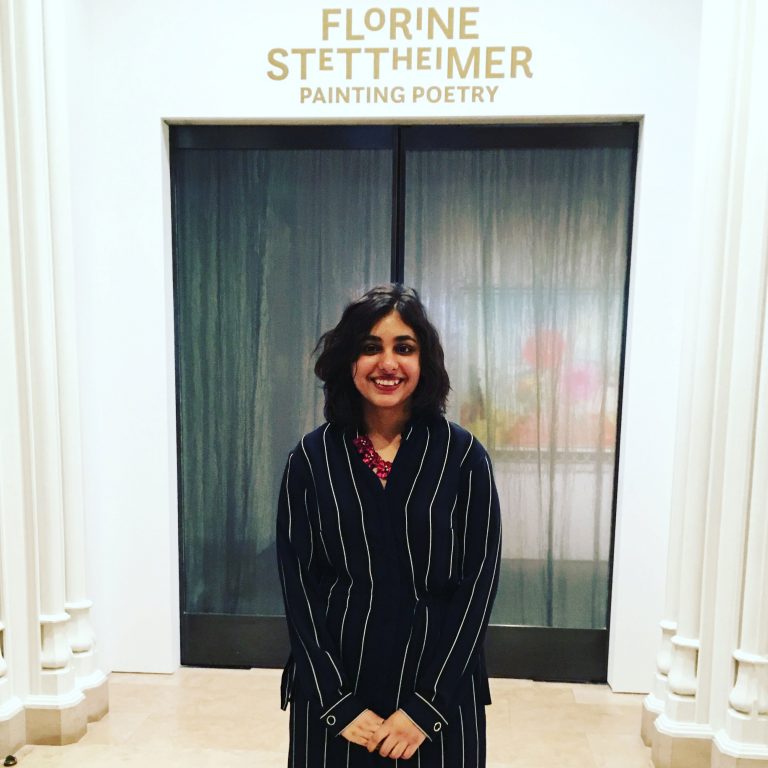Alumna Sukrita Baijal at a recently opened exhibition at the Jewish Museum
As Northeastern alumna Sukrita Baijal, CSSH’16, can attest, art history is one of the most effective ways to not only gain a better knowledge of history, but also to have a better emotional understanding of the past. Sukrita, who majored in history, joined the CAMD community at Northeastern when she took on an Art History minor during her junior year. Since graduating, Sukrita has found that her experience in art history has allowed her to take her knowledge and apply it in innovative ways. Through her current work at the Jewish Museum in New York, Sukrita’s ability to connect with art has enabled her to be more effective and enthusiastic about the work she is doing. We recently spoke with Sukrita to learn, in her own words, more about the Art History program, and why she believes it has been a key force in her successes.
1. How did you come across Northeastern’s Art History classes and Art History minor?
I came across the Art History classes and Minor by happy accident when I was looking to fill an open elective during my junior year. A classmate suggested taking a course offered that semester on American Art. I figured it would be an interesting new perspective on studying American history, not really thinking much more of it than that.
It turned out to be an enlightening experience because it was a small group of people from very different disciplines & backgrounds discussing art, culture, and history that made the arts feel accessible to me in a way that it never had before.
After taking that class, I added the Art History minor to my coursework.
2. What sort of course work does the Art History minor involve? What types of classes and extracurricular experiences are involved?
As an Art History minor, you not only get a comprehensive understanding of art movements through the two survey courses offered that span Ancient to Contemporary Art, but you also get to hone into your specific interests with courses such as Modern Art or 19th Century Art that delve deeper into those artistic periods.
In Art History classes, you have in-class discussions and lectures on art, conduct research and produce research papers based on your interests, and also make frequent visits to the Museum of Fine Arts (where all NU students have free admission!) to see and discuss works in person. We also took field trips to other museums and arts institutions like the Isabella Stewart Gardner Museum or the Harvard Art Museums. Who doesn’t love field trips!
3. You were a History major – how did your Art History minor enhance your major?
As a History major, you can gain a thorough understanding of historical milestones and events through research and study, but you must be able to disassociate from the subject matter to be an unbiased historian.
Art History is unique in the sense that it is part art, part history, and part intuition. You must observe a painting, know the historical and artistic movements of the time that influenced it, but also let yourself feel what the artist wanted you to feel. Studying Art History in conjunction with History allowed me to connect on a deeper intellectual and emotional level with the past.
It is one thing to learn about the facts of WWII in a History class, but to see and feel the emotional toll of war on those who fought by observing their paintings or sculptures gives you a more holistic understanding of that moment in time from the perspective of someone who survived it. Art captures not only fact, but feeling.
4. What was your favorite Art History class you took while at Northeastern?
My favorite Art History class was Modern Art taught by Professor Milda Richardson because she encouraged me and my classmates to voice our points of view on the works we studied.
I wrote a research paper on Georgia O’Keefe, relating how the oft-cited notion that her flower paintings are overtly sexual first appeared due to the criticism from her male peers in the art world who saw her as a woman before an artist. I traced how it led to a change in her style and subject matter later in her career so she could distance herself from such criticism. Essentially, it was a review of her work through the lens of 21st century feminism. It continues to be one of the best things I wrote in college.
5. Can you tell me a little bit about your work at New York’s Jewish Museum? How does your knowledge from your Art History minor play into this?
I work in Membership & Development for the Jewish Museum. My responsibilities include ensuring the smooth operations of our department by providing support to our members, overseeing our volunteers, and assisting with events such as exhibition openings, lectures, etc.
My role puts me in direct contact with members and donors. It is vital when working in an art museum to be able to engage thoughtfully with donors and to be able to communicate the museum’s mission and exhibitions to gain their financial support. My educational background in Art History has given me the ability to do so with confidence.


